FIAT TIPO 5DOORS STATION WAGON 2018 Owner handbook (in English)
Manufacturer: FIAT, Model Year: 2018, Model line: TIPO 5DOORS STATION WAGON, Model: FIAT TIPO 5DOORS STATION WAGON 2018Pages: 292, PDF Size: 7.74 MB
Page 171 of 292
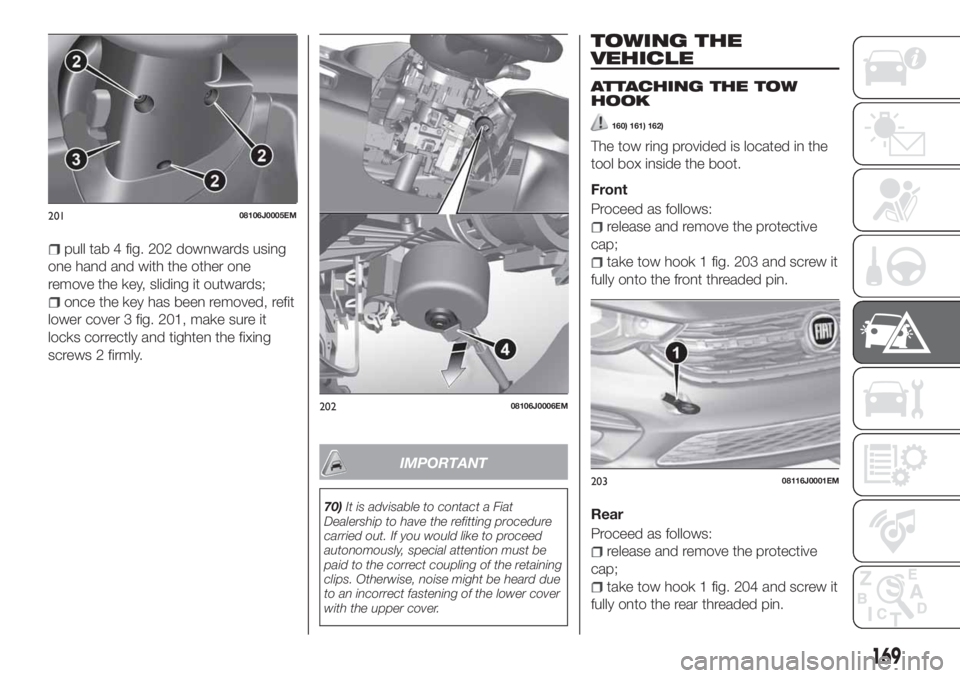
pull tab 4 fig. 202 downwards using
one hand and with the other one
remove the key, sliding it outwards;
once the key has been removed, refit
lower cover 3 fig. 201, make sure it
locks correctly and tighten the fixing
screws 2 firmly.
IMPORTANT
70)It is advisable to contact a Fiat
Dealership to have the refitting procedure
carried out. If you would like to proceed
autonomously, special attention must be
paid to the correct coupling of the retaining
clips. Otherwise, noise might be heard due
to an incorrect fastening of the lower cover
with the upper cover.
TOWING THE
VEHICLE
ATTACHING THE TOW
HOOK
160) 161) 162)
The tow ring provided is located in the
tool box inside the boot.
Front
Proceed as follows:
release and remove the protective
cap;
take tow hook 1 fig. 203 and screw it
fully onto the front threaded pin.
Rear
Proceed as follows:
release and remove the protective
cap;
take tow hook 1 fig. 204 and screw it
fully onto the rear threaded pin.
20108106J0005EM
20208106J0006EM
20308116J0001EM
169
Page 172 of 292
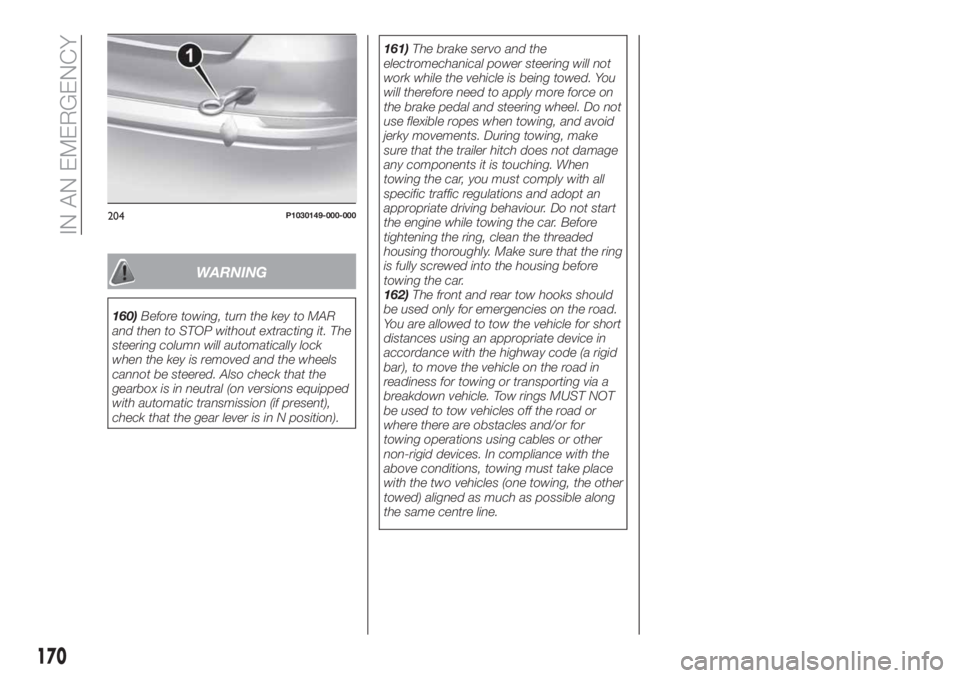
WARNING
160)Before towing, turn the key to MAR
and then to STOP without extracting it. The
steering column will automatically lock
when the key is removed and the wheels
cannot be steered. Also check that the
gearbox is in neutral (on versions equipped
with automatic transmission (if present),
check that the gear lever is in N position).161)The brake servo and the
electromechanical power steering will not
work while the vehicle is being towed. You
will therefore need to apply more force on
the brake pedal and steering wheel. Do not
use flexible ropes when towing, and avoid
jerky movements. During towing, make
sure that the trailer hitch does not damage
any components it is touching. When
towing the car, you must comply with all
specific traffic regulations and adopt an
appropriate driving behaviour. Do not start
the engine while towing the car. Before
tightening the ring, clean the threaded
housing thoroughly. Make sure that the ring
is fully screwed into the housing before
towing the car.
162)The front and rear tow hooks should
be used only for emergencies on the road.
You are allowed to tow the vehicle for short
distances using an appropriate device in
accordance with the highway code (a rigid
bar), to move the vehicle on the road in
readiness for towing or transporting via a
breakdown vehicle. Tow rings MUST NOT
be used to tow vehicles off the road or
where there are obstacles and/or for
towing operations using cables or other
non-rigid devices. In compliance with the
above conditions, towing must take place
with the two vehicles (one towing, the other
towed) aligned as much as possible along
the same centre line.
204P1030149-000-000
170
IN AN EMERGENCY
Page 173 of 292
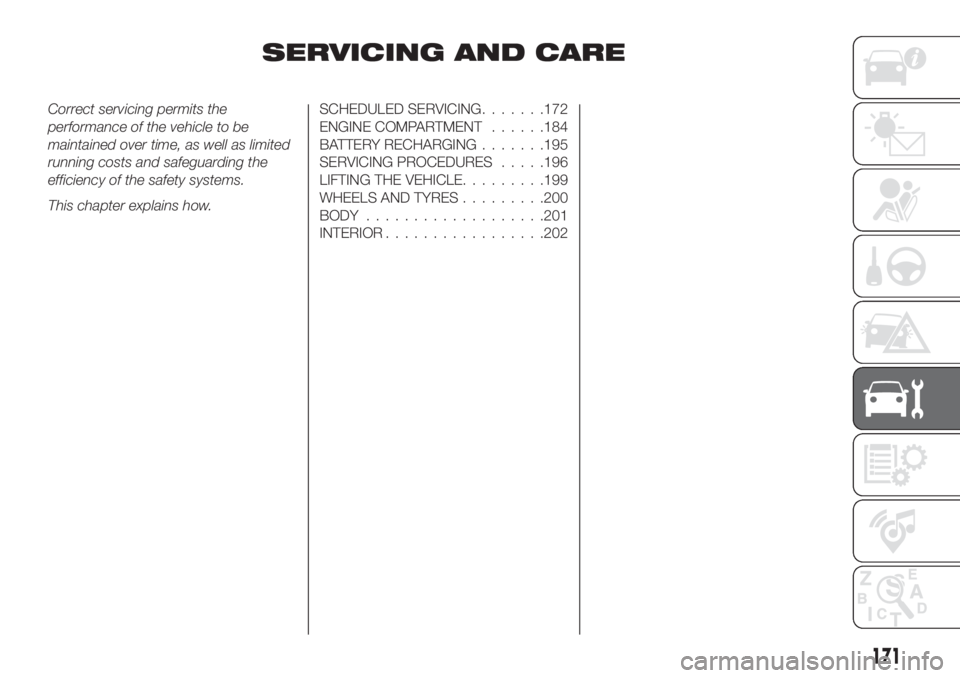
SERVICING AND CARE
Correct servicing permits the
performance of the vehicle to be
maintained over time, as well as limited
running costs and safeguarding the
efficiency of the safety systems.
This chapter explains how.SCHEDULED SERVICING.......172
ENGINE COMPARTMENT......184
BATTERY RECHARGING.......195
SERVICING PROCEDURES.....196
LIFTING THE VEHICLE.........199
WHEELS AND TYRES.........200
BODY...................201
INTERIOR.................202
171
Page 174 of 292
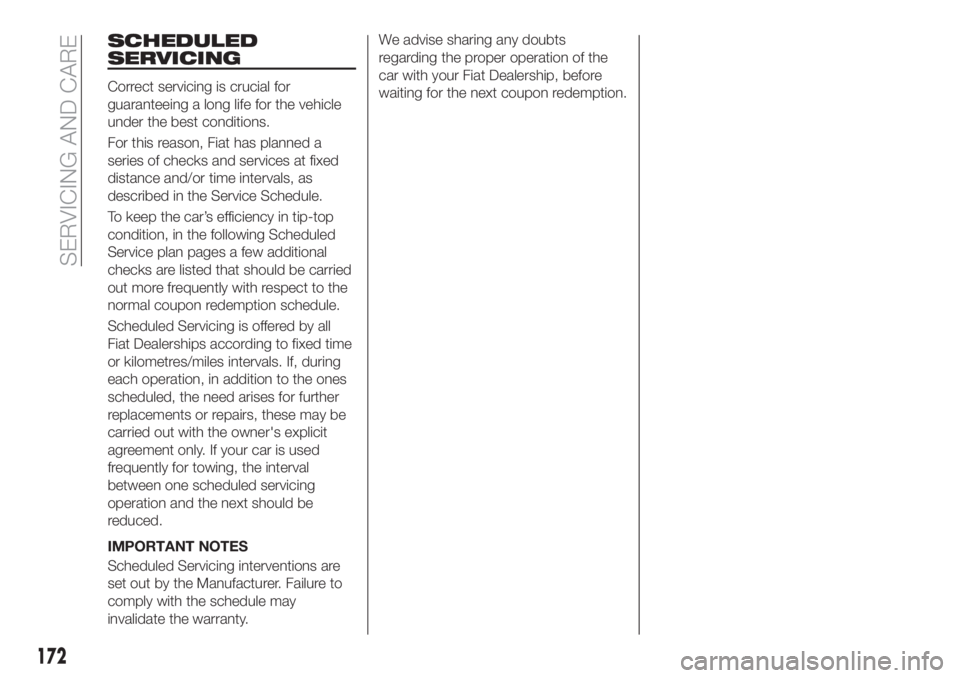
SCHEDULED
SERVICING
Correct servicing is crucial for
guaranteeing a long life for the vehicle
under the best conditions.
For this reason, Fiat has planned a
series of checks and services at fixed
distance and/or time intervals, as
described in the Service Schedule.
To keep the car’s efficiency in tip-top
condition, in the following Scheduled
Service plan pages a few additional
checks are listed that should be carried
out more frequently with respect to the
normal coupon redemption schedule.
Scheduled Servicing is offered by all
Fiat Dealerships according to fixed time
or kilometres/miles intervals. If, during
each operation, in addition to the ones
scheduled, the need arises for further
replacements or repairs, these may be
carried out with the owner's explicit
agreement only. If your car is used
frequently for towing, the interval
between one scheduled servicing
operation and the next should be
reduced.
IMPORTANT NOTES
Scheduled Servicing interventions are
set out by the Manufacturer. Failure to
comply with the schedule may
invalidate the warranty.We advise sharing any doubts
regarding the proper operation of the
car with your Fiat Dealership, before
waiting for the next coupon redemption.
172
SERVICING AND CARE
Page 175 of 292
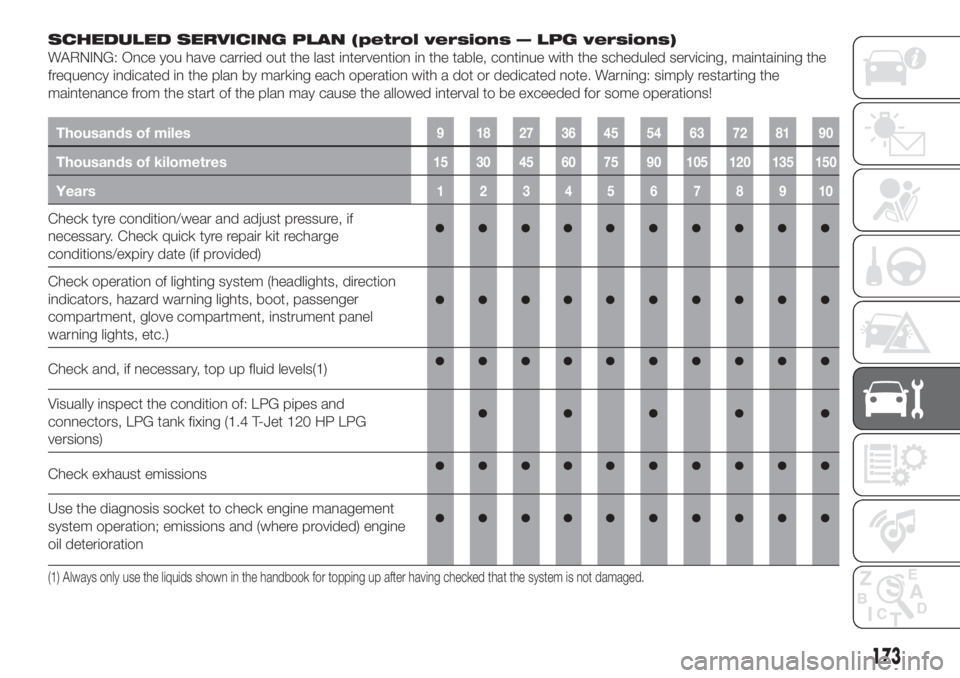
SCHEDULED SERVICING PLAN (petrol versions — LPG versions)
WARNING: Once you have carried out the last intervention in the table, continue with the scheduled servicing, maintaining the
frequency indicated in the plan by marking each operation with a dot or dedicated note. Warning: simply restarting the
maintenance from the start of the plan may cause the allowed interval to be exceeded for some operations!
Thousands of miles9 182736455463728190
Thousands of kilometres15 30 45 60 75 90 105 120 135 150
Years12345678910
Check tyre condition/wear and adjust pressure, if
necessary. Check quick tyre repair kit recharge
conditions/expiry date (if provided)
Check operation of lighting system (headlights, direction
indicators, hazard warning lights, boot, passenger
compartment, glove compartment, instrument panel
warning lights, etc.)
Check and, if necessary, top up fluid levels(1)
Visually inspect the condition of: LPG pipes and
connectors, LPG tank fixing (1.4 T-Jet 120 HP LPG
versions)
Check exhaust emissions
Use the diagnosis socket to check engine management
system operation; emissions and (where provided) engine
oil deterioration
(1) Always only use the liquids shown in the handbook for topping up after having checked that the system is not damaged.
173
Page 176 of 292
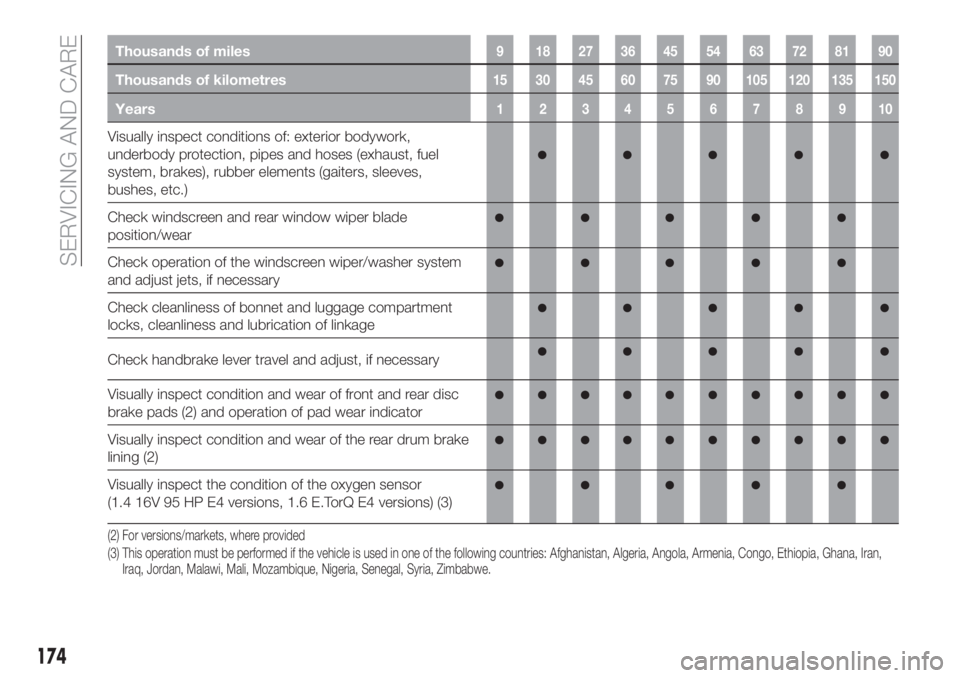
Thousands of miles9 182736455463728190
Thousands of kilometres15 30 45 60 75 90 105 120 135 150
Years12345678910
Visually inspect conditions of: exterior bodywork,
underbody protection, pipes and hoses (exhaust, fuel
system, brakes), rubber elements (gaiters, sleeves,
bushes, etc.)
Check windscreen and rear window wiper blade
position/wear
Check operation of the windscreen wiper/washer system
and adjust jets, if necessary
Check cleanliness of bonnet and luggage compartment
locks, cleanliness and lubrication of linkage
Check handbrake lever travel and adjust, if necessary
Visually inspect condition and wear of front and rear disc
brake pads (2)
and operation of pad wear indicator
Visually inspect condition and wear of the rear drum brake
lining (2)
Visually inspect the condition of the oxygen sensor
(1.4 16V 95 HP E4 versions, 1.6 E.TorQ E4 versions) (3)
(2) For versions/markets, where provided
(3) This operation must be performed if the vehicle is used in one of the following countries: Afghanistan, Algeria, Angola, Armenia, Congo, Ethiopia, Ghana, Iran,
Iraq, Jordan, Malawi, Mali, Mozambique, Nigeria, Senegal, Syria, Zimbabwe.
174
SERVICING AND CARE
Page 177 of 292
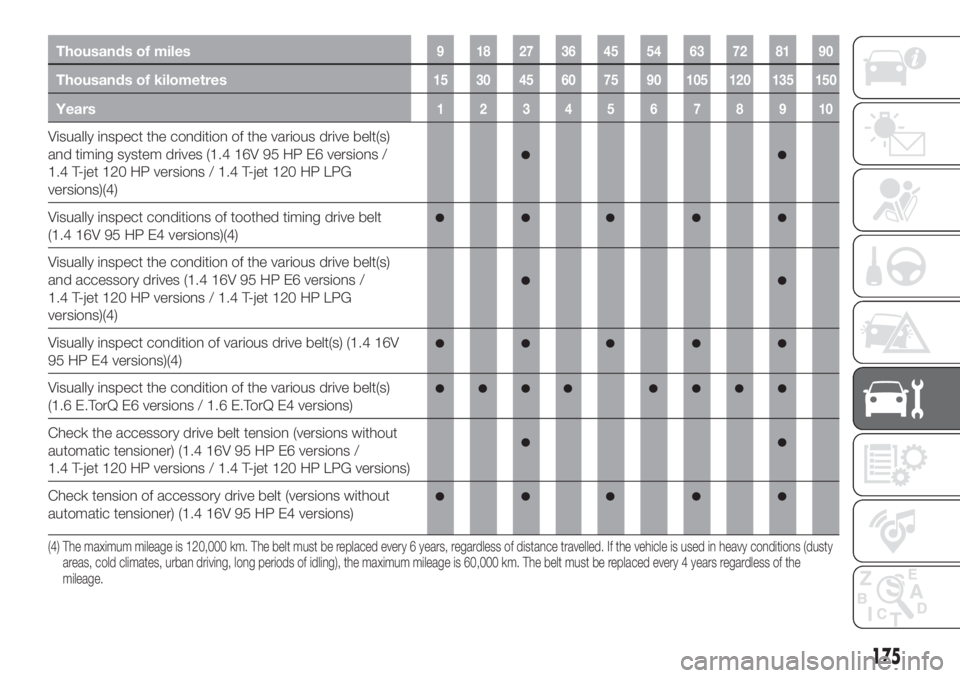
Thousands of miles9 182736455463728190
Thousands of kilometres15 30 45 60 75 90 105 120 135 150
Years12345678910
Visually inspect the condition of the various drive belt(s)
and timing system drives (1.4 16V 95 HP E6 versions /
1.4 T-jet 120 HP versions / 1.4 T-jet 120 HP LPG
versions)(4)
Visually inspect conditions of toothed timing drive belt
(1.4 16V 95 HP E4 versions)(4)
Visually inspect the condition of the various drive belt(s)
and accessory drives (1.4 16V 95 HP E6 versions /
1.4 T-jet 120 HP versions / 1.4 T-jet 120 HP LPG
versions)(4)
Visually inspect condition of various drive belt(s) (1.4 16V
95 HP E4 versions)(4)
Visually inspect the condition of the various drive belt(s)
(1.6 E.TorQ E6 versions / 1.6 E.TorQ E4 versions)
Check the accessory drive belt tension (versions without
automatic tensioner) (1.4 16V 95 HP E6 versions /
1.4 T-jet 120 HP versions / 1.4 T-jet 120 HP LPG versions)
Check tension of accessory drive belt (versions without
automatic tensioner) (1.4 16V 95 HP E4 versions)
(4) The maximum mileage is 120,000 km. The belt must be replaced every 6 years, regardless of distance travelled. If the vehicle is used in heavy conditions (dusty
areas, cold climates, urban driving, long periods of idling), the maximum mileage is 60,000 km. The belt must be replaced every 4 years regardless of the
mileage.
175
Page 178 of 292
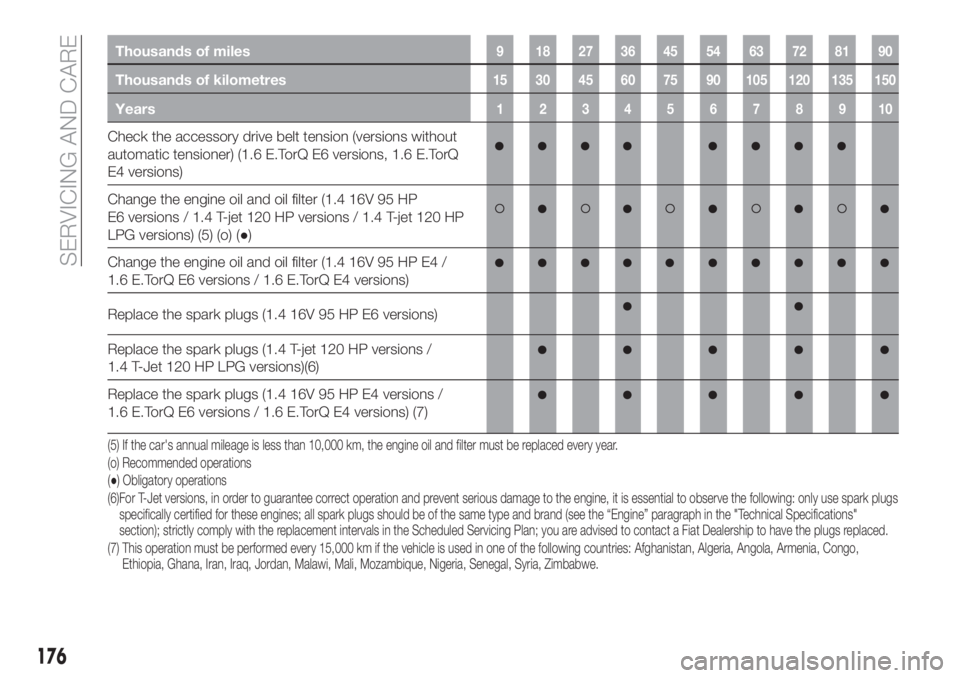
Thousands of miles9 182736455463728190
Thousands of kilometres15 30 45 60 75 90 105 120 135 150
Years12345678910
Check the accessory drive belt tension (versions without
automatic tensioner) (1.6 E.TorQ E6 versions, 1.6 E.TorQ
E4 versions)
Change the engine oil and oil filter (1.4 16V 95 HP
E6 versions / 1.4 T-jet 120 HP versions / 1.4 T-jet 120 HP
LPG versions) (5) (o) (●)
Change the engine oil and oil filter (1.4 16V 95 HP E4 /
1.6 E.TorQ E6 versions / 1.6 E.TorQ E4 versions)
Replace the spark plugs (1.4 16V 95 HP E6 versions)
Replace the spark plugs (1.4 T-jet 120 HP versions /
1.4 T-Jet 120 HP LPG versions)(6)
Replace the spark plugs (1.4 16V 95 HP E4 versions /
1.6 E.TorQ E6 versions / 1.6 E.TorQ E4 versions) (7)
(5) If the car's annual mileage is less than 10,000 km, the engine oil and filter must be replaced every year.
(o) Recommended operations
(●) Obligatory operations
(6)For T-Jet versions, in order to guarantee correct operation and prevent serious damage to the engine, it is essential to observe the following: only use spark plugs
specifically certified for these engines; all spark plugs should be of the same type and brand (see the “Engine” paragraph in the "Technical Specifications"
section); strictly comply with the replacement intervals in the Scheduled Servicing Plan; you are advised to contact a Fiat Dealership to have the plugs replaced.
(7) This operation must be performed every 15,000 km if the vehicle is used in one of the following countries: Afghanistan, Algeria, Angola, Armenia, Congo,
Ethiopia, Ghana, Iran, Iraq, Jordan, Malawi, Mali, Mozambique, Nigeria, Senegal, Syria, Zimbabwe.
176
SERVICING AND CARE
Page 179 of 292
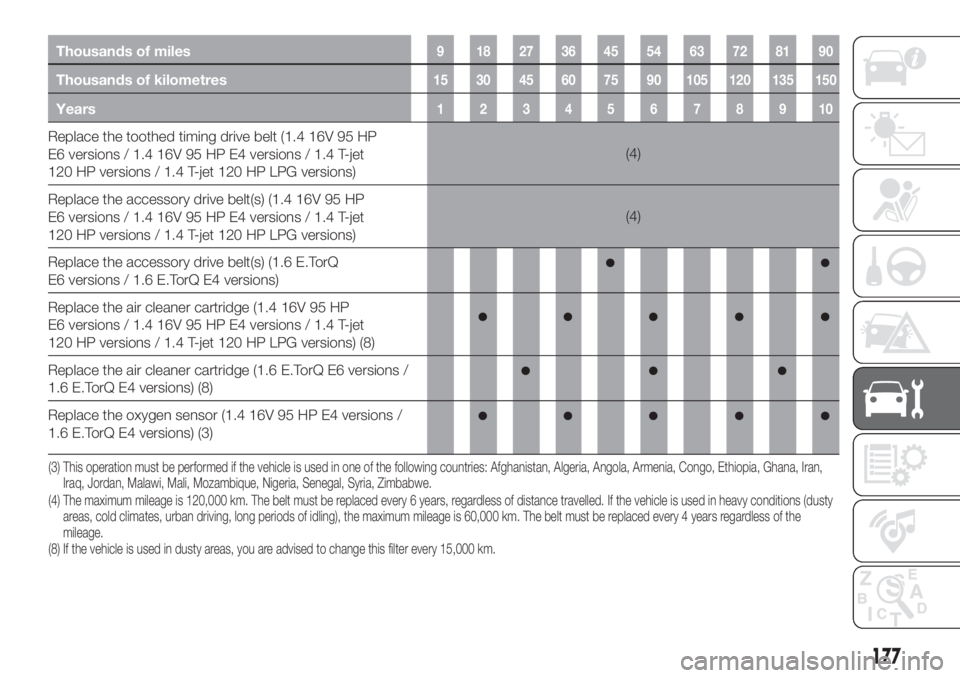
Thousands of miles9 182736455463728190
Thousands of kilometres15 30 45 60 75 90 105 120 135 150
Years12345678910
Replace the toothed timing drive belt (1.4 16V 95 HP
E6 versions / 1.4 16V 95 HP E4 versions / 1.4 T-jet
120 HP versions / 1.4 T-jet 120 HP LPG versions)(4)
Replace the accessory drive belt(s) (1.4 16V 95 HP
E6 versions / 1.4 16V 95 HP E4 versions / 1.4 T-jet
120 HP versions / 1.4 T-jet 120 HP LPG versions)(4)
Replace the accessory drive belt(s) (1.6 E.TorQ
E6 versions / 1.6 E.TorQ E4 versions)
Replace the air cleaner cartridge (1.4 16V 95 HP
E6 versions / 1.4 16V 95 HP E4 versions / 1.4 T-jet
120 HP versions / 1.4 T-jet 120 HP LPG versions) (8)
Replace the air cleaner cartridge (1.6 E.TorQ E6 versions /
1.6 E.TorQ E4 versions) (8)
Replace the oxygen sensor (1.4 16V 95 HP E4 versions /
1.6 E.TorQ E4 versions) (3)
177
(4) The maximum mileage is 120,000 km. The belt must be replaced every 6 years, regardless of distance travelled. If the vehicle is used in heavy conditions (dusty
areas, cold climates, urban driving, long periods of idling), the maximum mileage is 60,000 km. The belt must be replaced every 4 years regardless of the
mileage.
(8) If the vehicle is used in dusty areas, you are advised to change this filter every 15,000 km. (3) This operation must be performed if the vehicle is used in one of the following countries: Afghanistan, Algeria, Angola, Armenia, Congo, Ethiopia, Ghana, Iran,
Iraq, Jordan, Malawi, Mali, Mozambique, Nigeria, Senegal, Syria, Zimbabwe.
Page 180 of 292
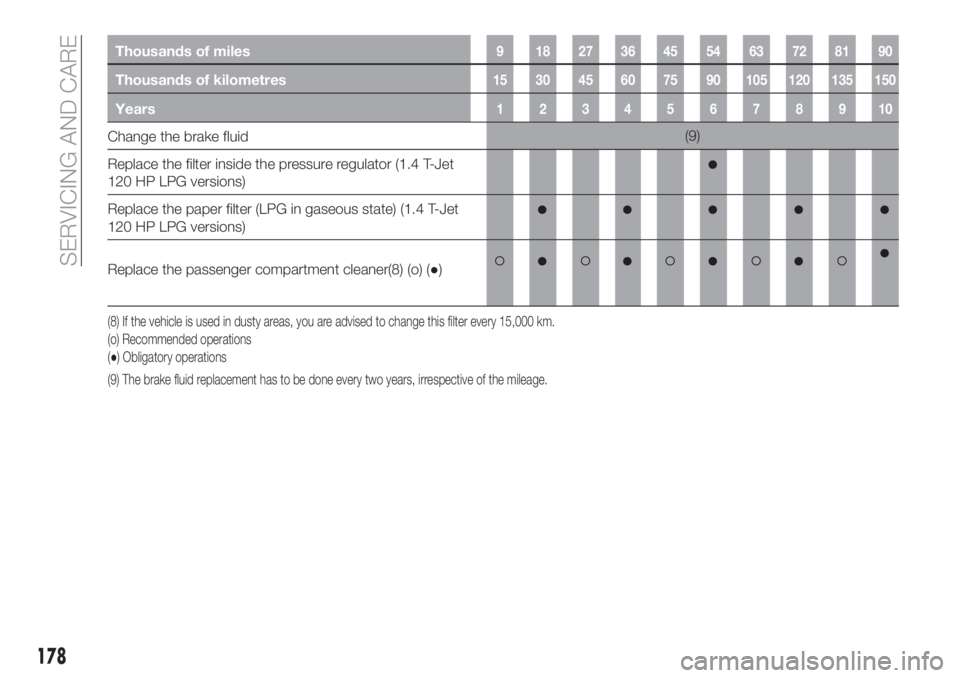
Thousands of miles9 182736455463728190
Thousands of kilometres15 30 45 60 75 90 105 120 135 150
Years12345678910
Change the brake fluid(9)
Replace the filter inside the pressure regulator (1.4 T-Jet
120 HP LPG versions)
Replace the paper filter (LPG in gaseous state) (1.4 T-Jet
120 HP LPG versions)
Replace the passenger compartment cleaner(8) (o) (●)
(9) The brake fluid replacement has to be done every two years, irrespective of the mileage. (8) If the vehicle is used in dusty areas, you are advised to change this filter every 15,000 km.
(o) Recommended operations
(●) Obligatory operations
178
SERVICING AND CARE